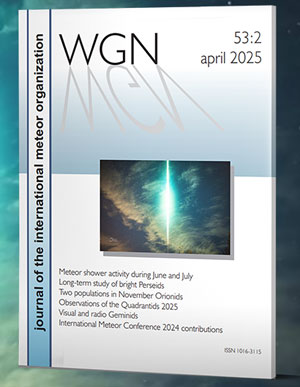April has one major annual shower and the start
of another. The Lyrids are active from April 16-25 and reach maximum activity on
the 22nd. While not the strongest annual shower they produce much better rates
than has been seen for the past three months. The Eta Aquarids also reach a ZHR
of one on April 19 and slowly continue to increase in strength as the month
progresses. Sporadic rates seen in the northern hemisphere are actually worse
than those seen in March. This trend will continue through June. On the other
hand rates seen from the southern hemisphere are increasing toward a July
maximum.
During this period the moon reaches its last
quarter phase on Tuesday April 10. At this time the moon will rise near 0100 and
will be in the sky the remainder of the morning. One can still hold successful
observations simply by keeping the moon out of your field of view. The estimated
total hourly rates for evening observers this week is near two for those north of
the equator and three for observers south of the equator. For morning observers
the estimated total hourly rates should be near six for northern observers and
twelve for those south of the equator. These rates assume that you are watching
from rural areas away from all sources of light pollution. The actual rates will
also depend on factors such as personal light and motion perception, local weather
conditions, alertness and experience in watching meteor activity. Morning
rates are reduced due to moonlight.
The radiant positions listed below are exact for Saturday
night/Sunday morning April 7/8. These positions do not change greatly day to day
so the listed coordinates may be used during this entire period. Most star atlases
(available at science stores and planetariums) will provide maps with grid lines
of the celestial coordinates so that you may find out exactly where these positions
are located in the sky. A planisphere or computer planetarium program is also useful
in showing the sky at any time of night on any date of the year. Activity from each
radiant is best seen when it is positioned highest in the sky, either due north or
south along the meridian, depending on your latitude. It must be remembered that
meteor activity is rarely seen at the radiant position. Rather they shoot outwards
from the radiant so it is best to center your field of view so that the radiant lies
at the edge and not the center. Doing this will allow you to easily trace the path
of each meteor back to the radiant (if it is a shower member) or in another direction
if it is a sporadic. Meteor activity is not seen from radiants that are located
below the horizon. The positions below are listed in a west to east manner in
order of right ascension (celestial longitude). The positions listed first are
located further west therefore are accessible earlier in the night while those
listed further down the list rise later in the night.
The Antihelion (ANT) radiant is now centered at 14:04 (211) -12. This area
of the sky is centered in southeastern Virgo, three degrees southwest of the fourth
magnitude star Kappa Virginis. This radiant is best placed near 0200 LDT when it
lies on the meridian and is highest in the sky. Rates at this time should be near
two per hour no matter your location. With an entry velocity of 30 km/sec., the
average Antihelion meteor would be of medium-slow speed.
Sporadic rates are slowing decreasing for observers in the northern
hemisphere and slightly rising for those south of the equator. One would expect
to see perhaps six random meteors during the last hour before dawn from rural
observing sites located in the northern hemisphere. During the first dark hour
after the end of evening twilight, perhaps two random meteors can be seen per
hour. Sporadic rates increase as the night progresses so rates seen near
midnight would be near four per hour. Late morning sporadic rates seen from the
southern hemisphere are now near a ten per hour from rural observing sites.
During the first dark hour after the end of evening twilight, perhaps three
random meteors can be seen per hour, increasing to eight by midnight. Morning
rates are reduced due to moonlight.
| SHOWER | DATE OF MAXIMUM ACTIVITY | CELESTIAL POSITION | ENTRY VELOCITY | CULMINATION | HOURLY RATE | CLASS* | RA (RA in Deg.) DEC | Km/Sec | Local Standard Time | North-South | Antihelion (ANT) | – | 14:04 (211) -12 | 30 | 02:00 | 2 – 2 | II |




 You saw something bright and fast? Like a huge shooting star? Report it: it may be a fireball.
You saw something bright and fast? Like a huge shooting star? Report it: it may be a fireball.  You counted meteors last night? Share your results with us!
You counted meteors last night? Share your results with us!  You took a photo of a meteor or fireball? You have a screenshot of your cam? Share it with us!
You took a photo of a meteor or fireball? You have a screenshot of your cam? Share it with us!  You caught a meteor or fireball on video? Share your video with us!
You caught a meteor or fireball on video? Share your video with us!